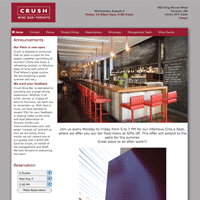Online reservation systems open a floodgate of possibilities for operators
The once-mighty pen is entrenched in a fight it could lose. As the electronic age progresses, restaurateurs are finding new, faster and more innovative ways to record and retain information, and when it comes to booking reservations, technology offers benefits that give the traditional pen and paper some stiff competition.
A key selling point of technology is convenience, and foodservice operators can now cater to the needs of busy consumers by offering online reservation systems, accessible from the restaurant’s own website — or even through the customer’s smartphone. And the process couldn’t be easier. Diners key in the date and time they wish to eat, and the information is fed directly to the resto’s reservation system.
“Online reservation systems like Open Table do a variety of things,” says Doug Fisher, president of FHG International, a Toronto-based foodservice and franchise consultancy firm, explaining a popular American online system. “Presiding over a reservation system is complex. [Going the online reservation route] is good from a marketing and administration standpoint. The Open Table reservations go in instantaneously and are immediately included in the in-house reservation system.”
Mark Moffatt, general manager of upscale Toronto resto Crush Wine Bar, couldn’t agree more. “The ability to reach a broader customer base and email clients about upcoming events they might be interested in [is a benefit],” he explains. There’s the accessibility of clients to us and being able to track preferences and number of visits.”
It’s a similar story at Calgary’s River Café. “We’ve had an online reservation system for five years now,” says Kristi Peters, general manager of the trendy fine-dining favourite. “It’s more efficient. We make fewer mistakes, and we’re able to track clientele. If we see repeat reservations from one customer, we can take note and make sure we have the wine he likes.”
Peters contends that systems like Open Table are good for saving time, money and for forecasting numbers. A reservation report showing how many people to expect at 7 p.m., for example, helps wait and kitchen staff better prepare for a busy (or quiet) night.
From a customer’s perspective, it can improve the dining experience too, as systems quickly and accurately guarantee a diner a table in minutes. “When I was at a restaurant in Banff, I was told I’d have to wait an hour and a half for a table,” says Fisher, recalling a particularly telling example. “I went outside, made an Open Table reservation on my phone and got a table right away.”
On the downside, there are some drawbacks to reservation systems, such as technological failures, lost or incorrectly input reservations and the possibility diners who book may not show. Other times, technology-related ills can make it difficult for restaurant staff to field reservations. “There are times when Internet connections go down, which is an inconvenience,” adds Moffatt.
The budget is another factor that might deter owners of smaller restaurants still emerging from the economic thundercloud of 2009. Open Table charges about $600 to $700 for installation, as well as a monthly $270 fee. A cheaper option is Canadian-owned hospitality management system Click ‘N’ Reserve — which also functions as a client-management system — and costs $400 a year for an unlimited reservation program.
For some restaurateurs, the costs are worth it. “For what it provides, the costs are extremely manageable,” says Moffatt. “Even for smaller restaurants, it has benefits. Imagine the look on a guest’s face when you have a birthday card prepared in advance, because Open Table recalls it’s [your birthday]. Regardless of the size of your establishment, that has impact.”





















